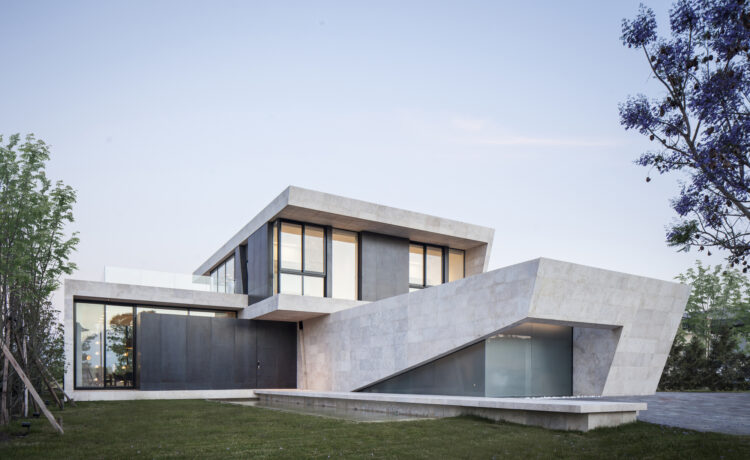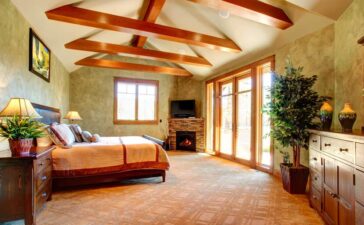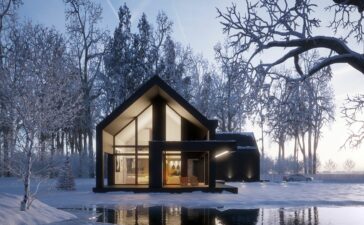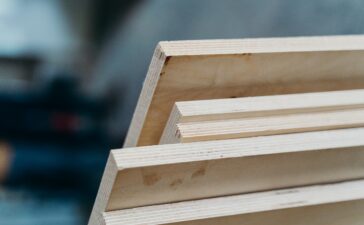Stone adds a touch of elegance to any house and is highly durable because it can withstand different elements for a long time. It is affordable and requires less maintenance. Houses that have a stone facade look timeless, and stones keep the inside of the house cool and nice.
Stones are also versatile because they can be used on the inside and outside of the house. Therefore, adding stone to the house can be a huge benefit, especially if it is used as cladding (material added to the exterior surface of the house for weather protection). Every stone looks unique and comes at a different price and level of durability.
But if you don’t know where to look, we have compiled a list of 19 types of stone for house exteriors that look majestic.
Types of Stone for House Exterior
1. Granite
Granite is one of the most commonly used stones for house exteriors because it is very durable, comes in several colors, and looks stunning. It is resistant to heat and moisture in the air, and it is not easy to disrupt its texture as well.
This quality of withstanding different climates is one of the main reasons why this stone is preferred. In addition, adding this to the house exterior gives it an elegant appearance. Overall, this stone is highly reliable.

2. Limestone
Limestone can easily be cut into several shapes, and it has a beautiful rustic appearance. It can withstand extremely hot temperatures and cools the house at the same time. Limestone is available in different shades of white, yellow, brown, and gray.
Therefore, it is one of the most aesthetic types of stone for house exteriors. However, one disadvantage of using limestone is that it gets easily stained and scratched, and this will be very visible because of its lighter shades. So it requires some extra maintenance.

3. Gneiss
This consists of alternating patterns of small light and dark stones. These small stones are usually not even in size, shape, color, and texture, giving it a striking appearance. The most common colors found are black, white, and shades of brown.
The patterns or bands come in different shapes, such as wavy, straight, or uneven. You can either add the stones together and use them as one slab, or you can break up the stones and use them separately. It can also withstand different weather conditions.

4. Quartzite
This stone is very similar to marble in its appearance and characteristics, as it is also highly durable. Its quality remains the same even in different weather conditions, and it is also easy to clean and maintain.
One difference between this and marble is that this has a crystalline structure that makes it shiny, twinkling, and more appealing. It also comes in different colors, such as white, gray, light brown, etc. Adding this to your walls can give your house a classy appearance.

5. Travertine
This natural stone Travertine comes in colors like light brown, pink, pale white, tan, pink, orange, blue, etc. It has a low water absorption rate and is not abrasive. It is very commonly used in house construction (kitchens, exterior of the house, swimming pools, etc.) because of its wide range of color options and properties.
However, it has cavities that are usually filled with grout so that it doesn’t crack easily. Overall, it is one of the most beautiful stones available that is also efficient in different weather conditions.

6. Sandstone
These stones are formed as sand gets hardened over a period of time and, therefore, look similar to sand’s color. It has a wonderful shine when exposed to sunlight. It is resistant to heat however is not very resistant to water. Therefore, it is best to install them in areas where there is less rainfall and moisture.
However, when installed in wetter regions, it does have a unique property as it is not slippery and provides quite a grip when you walk. Therefore, it is commonly used for natural-looking steps in parks and gardens. It doesn’t require high maintenance, and the color remains bright even after being exposed to extremely hot weather.

7. Flint
It has a unique texture and can withstand different weather conditions, including extremely humid conditions. In cold weather, it keeps the inside of the house warm and comfortable. In addition, it can be cut into any desired shape and can be made into different designs. It comes in colors such as gray, blue, black, etc.
It is commonly seen in England in its churches, farmhouses, etc. It has a very textured appearance and is visually very pleasing to the eye. As it has been tested and tried several times, this stone has to be considered as a potential choice for your house exterior.

8. Slate
This is one of the most durable stones as it can withstand extreme weather, is resistant to water, and doesn’t corrode even due to acid rain. This also doesn’t crack easily and retains its texture for a long time. It naturally comes in darker colors, such as black and gray but is also available in colors, such as green and blue.
This is easy to clean and gives the exterior of your house a modern appearance. Additionally, this stone, due to its beautiful grains and colors, is used for both interior and exterior design work.

9. Onyx
This belongs to the marble family and looks absolutely magnificent as it has many bands that vary slightly in color and also have grains. It comes in colors such as tan, brown, black, gray, etc. However, this is not one of the commonly used types of stone for house exteriors, as this is a bit more expensive and difficult to obtain.
It has a stunning glossy appearance, and therefore, if it is added to your house exterior, it will give a majestic appearance to your house. It is also resistant to heat and mixture and can be used in wet regions without losing its properties.

10. Steatite/Soapstone
It is called soapstone because it has a soapy texture, and it is naturally available in gray and its shades only. This might rarely be available in white and brown colors. It provides good heat insulation and can be easily cut into different shapes.
It doesn’t get stained easily but is not that resistant to moisture and water when compared to other stones like marble, limestone, etc. It is commonly used in house interiors due to its intricate appearance, but it has been used for house exteriors as well.

11. Marble
Marble has been used for different purposes like in the kitchen, flooring, house exterior, or cladding due to its striking appearance. It is simple yet classy while being heat and water-resistant. They don’t easily crack or stain. In addition, they are slightly translucent and therefore reflect light.
For this reason, they are commonly used in luxurious buildings and monuments. They have to be carefully installed, however, due to their appearance. If added to your house exterior, this stone will make your house look highly sophisticated.

12. Jerusalem Stone
This is a light-colored stone that was commonly used in Jerusalem and the Mediterranean areas. This is a stone that has been used in the monuments found in Jerusalem, and hence the stone received its name. It comes in colors such as white, yellow, light pink, orange, brown, etc. It can withstand different weather conditions and has a low water absorption rate.
It is available in different colors, shapes, and sizes and can be installed easily, but attention needs to be paid. Authentic Jerusalem stones need to be transported, and this aspect makes it a little expensive. But this stone is also commonly used for house exteriors.

13. Schist Stone
This natural stone comes in both warm and cool color tones and textures. It has been used for house exteriors as it looks stunning by creating an earthy aesthetic. Therefore, this is a good choice for houses that look more traditional. It can withstand different weather conditions and has grains that can be seen easily.
This stone might not be easy to obtain as it is rare. But it is easy to clean and maintain, has a low water absorption rate, is not abrasive, and so it is highly durable. Therefore, this is one of the types of stone for house exteriors that can be considered.

14. Faux Stone
These are not real stones and are polyurethane based. These have different qualities when compared to stones, as they are more lightweight and less expensive. These are usually available as panels rather than individual stones and so are very easy to transport and install.
To the untrained eye, they look like authentic stones. They are available in different colors and can be made into different shapes as well. So this stone is a good alternative to real stones as these are a bit easy on the pocket.

15. Basalt
This stone is formed after volcanic lava is cooled down, and its composition mainly consists of silica. It usually comes in darker colors, like dark gray. It has very fine grains, and it is also resistant to harsh weather conditions and provides good insulation.
Due to its appearance, this is also used in modern architecture. However, it is also a bit more expensive due to its rarity, but if used for the house exterior, it will be a good investment.

16. Serpentine Stone
This looks unique in its appearance as it comes in different shades of green depending on where it is obtained from. This has fine grains, is resistant to chemicals and acid rain, has good heat and moisture resistance, and doesn’t easily crack or stain.
Due to these reasons, it has been used for exterior house cladding. But since this stone is also quite rare, it is not common to see serpentine stone cladding in houses. Considering its properties, it is a good choice for your house exterior as it will look royal and elegant.

17. Bluestone
This is not commonly used for house exteriors but is commonly used in pavements, pools, entryways, patios, etc. However, when it is added to the house exterior, it looks elegant. This stone is not slippery and can withstand different weather conditions like extreme heat or moisture.
This is a naturally available stone that has been used in construction for a while, and it can also be easily cut into different sizes and shapes. Sealing must be done so that the stone doesn’t crack easily and is protected from chemical damage. Therefore, this stone can be considered for your house exterior.

18. Concrete Stone
Although this is not a stone by itself, cement is molded in shapes, and it is put together to create these concrete stones. Because of this, these stones can be easily modified into any shape or pattern. It is extremely durable and can withstand different weather.
This might be relatively less expensive when compared to other stones. When added, these types of stone for the house exterior give it a modern and sleek look. That is why these stones are the preferred type of cladding for buildings that look contemporary.

19. Engineered Stone
This is not a natural stone, as it is made of small stones that are crushed and put together with the help of adhesives. It has a similar appearance to natural stone and comes in different colors, sizes, and shapes. It is also durable and can withstand different weather conditions like natural stone. However natural stones last longer, but depending on the quality, these stones may not do so.
One of the main differences between natural and engineered stones is that natural stones tend to have different shades, hues, and textures throughout, while these engineered stones have a more uniform appearance. These can act as a good, less expensive option for the house exterior.

Conclusion
When a house is built, it is done so with the intention that it should be passed on to generations. And to do this, it needs to be protected from harsh weather conditions such as extreme heat, rain, moisture, etc., and it also shouldn’t get cracked or stained.
One easy way to protect the house from these elements is to add stones to the house exterior, known as house cladding. Most stones are naturally formed and therefore can withstand different weather conditions while enhancing the house’s appearance. Different types of stones have different qualities, appearances, textures, colors, and sizes, and depending on the requirement, specific stones can be chosen.
Some of the commonly used types of stone for house exteriors include marble, granite, sandstone, travertine, quartzite, limestone, etc. Some of these might work especially well for certain climates, and it is important to choose them accordingly.
Frequently Asked Questions
Why Should I Add Stones to The House Exterior?
Adding stones to your house’s exterior will protect it from different weather conditions like heat, moisture, acid rain, etc., and will also improve the appearance of the house by making it look more majestic. In addition, adding stones to your house exterior will protect your house from small cracks and stains, as these stones are easy to clean and maintain.
Are There Any Less Expensive Alternatives to Natural Stones for House Exteriors?
Yes, engineered and concrete stones are not natural, and they are not as expensive as natural stones. Engineered stones are made with crushed small stones stuck together by an adhesive, and these look uniform in appearance, unlike natural stones. Concrete stones are made by molding concrete together in desired shapes and then adding whatever texture is preferred. Both of these stones are highly durable as well.









